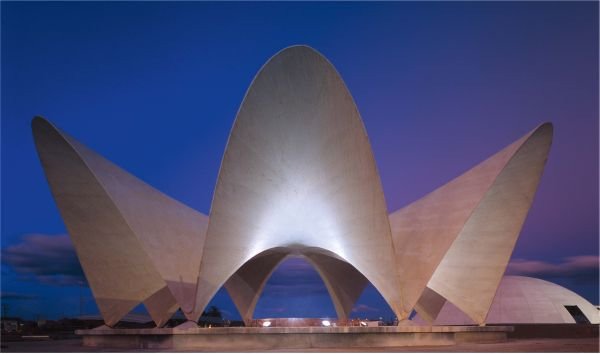Felix Candela
dal 20/10/2010 al 1/1/2011
Segnalato da
20/10/2010
Felix Candela
IVAM Instituto Valenciano de Arte Moderno, Valencia
1910 - 2010

Félix Candela (Madrid, 1910 – Raleigh, North Carolina, 1997) left his mark on twentieth-century architecture with the reinforced concrete structures, popularly known as shells, which he built in the fifties and sixties. He arrived in Mexico in 1939 and the company that he set up, Cubiertas Ala, produced designs for over 1400 projects, of which nearly 900 were constructed. International architecture and engineering gained an individual form of expression with Candela’s contributions as he broke down boundaries and opened up new directions in the design of structures with resistant forms that generated architectural spaces of great richness. His influence spread throughout the world and can still be found in the formal expression of various contemporary architects. His creativity reached beyond frontiers, for there are roofs by him in Colombia, Ecuador, Spain, the United States, Guatemala, Mexico, Norway, Peru, Puerto Rico, the United Kingdom and Venezuela. He is considered a precursor of sustainable architecture because of his commitment to producing work that was enduring, economical and beautiful.
This exhibition, organised by the State Society for Cultural Commemoration (SECC) and the Institut Valencià d’Art Modern (IVAM) with the collaboration of the National Autonomous University of Mexico (UNAM) commemorates the centenary of Félix Candela’s birth. It brings together, for the first time, a selection from the three archives that preserve his legacy: Columbia University’s Félix Candela Archive, Princeton University’s Félix and Dorothy Candela Archive and the UNAM’s Candela Martín Archive. The selection consists of original plans, period photographs and documents, ranging from his university notes to notebooks related to lectures and projects belonging to his final years, when he was already an architect of international prestige.
The show is organised around 21 models of Candela’s main projects, made for this exhibition by the UNAM’s Architecture Department. A further section includes a selection of photographs about his work by renowned photographers such as Armando Salas Portugal, George Miller, Juan Guzmán and Nacho López. There will also be showings of three videos about his work by the Mexican artist Onnis Luque, a documentary, Aquella primavera creadora (That Creative Springtime), which places Candela’s work in the context of his contemporaries, and animations of 20 emblematic works.
Prizes and awards
He was awarded the International Union of Architects’ Auguste Perret Prize and the Institution of Structural Engineers’ Gold Medal, both in 1961, eight days apart. He also received the Spanish Architects’ Associations’ Gold Medal for Architecture in 1981 and the Antonio Camuñas Architecture Prize in 1985. He was awarded honorary doctorates by the University of New Mexico (1978), Santa María University in Caracas (1978), Seville University (1990) and Madrid Polytechnic University (1994). In 1961–62 he chaired the Charles Eliot Norton Lectures at Harvard University and from 1974 to 1977 he held the honorary title of Hoffman Wood Professor of Architecture at the University of Leeds.
Personal life
His childhood and adolescence were spent in Spain, and he graduated in Architecture in Madrid in 1935. He was awarded a Conde de Cartagena scholarship by the Real Academia de Bellas Artes de San Fernando to study in Germany, but was unable to do because of the outbreak of the Civil War. As a young man he was also an outstanding all-round sportsman.
In the health-conscious culture that prevailed at the time, he practised a number of different sports: he was the Castile pole vault champion and played in the Spanish rugby team, although the sport in which he excelled was skiing, and he was the Spanish ski jump champion in 1932.
He fought as a Captain in the Republican Army’s Engineers during the Civil War. At the age of 29 he went into exile in Mexico, where he reached his professional peak and achieved creative fulfilment by building emblematic works such as the Cosmic Rays Pavilion (1951) or the Sports Palace for the Mexico City Olympics (1968). In 1971 he emigrated to the United States, where he spent his last years devoted to academic activity and professional consultancy. In Spain there is a posthumous work by him, the roof of the restaurant of the Oceanogràfic, Valencia’s oceanographic museum.
Image: The Oceanogràfic in Valencia’s City of Arts and Sciences, a posthumous work by Félix Candela © Enrique Carrazoni
For any further request we invite you to address the Department of Communication (34) 96 3867679 or send an e-mail to comunicacion@ivam.es
IVAM Institut Valencià d'Art Modern
Guillem de Castro, 118, 46003 Valencia
Horary: From Tuesday to Sunday, 10:00 - 20:00. Closed mondays



